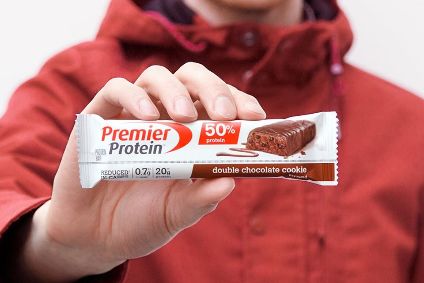
BellRing Brands has outlined a three-point strategy to drive growth in the US-based health and nutrition firm spun off by Post Holdings, with international expansion and M&A on the agenda further down the line.
Addressing analysts on Friday (22 November) after reporting a 3% increase in full-year sales to US$854m, BellRing Brands chief executive Darcy Davenport said boosting household penetration and distribution, along with product innovation form the main pillars of its strategy, while “international expansion and M&A are longer-term in nature”.
Until October, BellRing Brands was trading as Post Holdings’ Active Nutrition business before it was spun off into a new entity via a public offering of shares. The company raised a net $524m from the IPO and made its debut on the New York Stock Exchange on 17 October. Post still retains 71% of the business.
BellRing operates in the ready-to-drink (RTD) protein beverages segment, protein powders and nutrition bars, with Premier Protein its flagship brand, accompanied by Dymatize, PowerBar, Supreme Protein and Joint Juice.
According to Davenport, the convenient nutrition category in the US is worth around $17bn in sales and is growing about 7% annually, driven by trends such as “main streaming of proteins, convenience and snacking”.
Davenport describes BellRing Brands as a “fast-growing leader in the convenient nutrition category”. He added: “Our business has scale, double-digit growth, strong margins and high cash generation.”

US Tariffs are shifting - will you react or anticipate?
Don’t let policy changes catch you off guard. Stay proactive with real-time data and expert analysis.
By GlobalDataMargins were quite impressive at 23% for the fiscal year ended on 30 September based on EBITDA, an increase of 430 basis points. Adjusted EBITDA climbed 27% to $198m, while net earnings rose 28% to $123m.
The Premier Protein brand booked a 7% increase in sales for the year, ahead of the 4% gain for Dymatize. But PowerBar dropped 26%.
While the CEO said Premier Protein represents 80% of BellRing’s net sales, making it the “number one brand in the convenient nutrition category”, it only has 5% household penetration, “highlighting the brand’s untapped potential”.
Increasing marketing and promotional activities will therefore play a key role for Premier Protein in fiscal 2020, with Dymatize (13% of sales) and PowerBar (5%) offering “future upside to BellRing”, Davenport attests.
He added: “Expanding distribution is another growth driver, both within our existing channels, as well as new channels. Our biggest distribution opportunity is increasing our shelf space where we already have distribution. Premier Protein represents 16% of RTD category sales, but only represents 5% share of shelf.”
The CEO also highlighted the benefits of e-commerce, which is generating 6% of the company’s net sales and grew 30% in fiscal 2019.
For the time being though, Davenport said the focus will be centred on boosting organic growth in the business, namely through the Premier Protein brand, before looking at other export markets or embarking on M&A.
Since fiscal 2016, BellRing has expanded organically at a compound annual growth rate of 14%.
Nevertheless, Davenport said there were “significant growth opportunities” in existing overseas markets such as Canada and Western Europe, along with countries where it already has distribution presence, albeit a “nascent” one, including China, the UK and the Middle East.
“Regarding M&A, the category is very fragmented with many attractive targets. However, we believe the single biggest opportunity is to organically grow the Premier Protein brand,” he said.
Innovation is also going to play its part in delivering future growth, an area that has taken a back seat in the “last couple of years”, the CEO explained, and suggest new product launches will roll out early in the new year.
“January, February and March is really the big time for the category,” Davenport told analysts. “And so, we try to align our launches around that time to make sure we are there when consumers are entering the market. So, that gives you a sense of timing.”
Meanwhile, finance chief Paul Rode outlined the targets for 2020. Net sales are expected in a range of $1bn to $1.05bn, while adjusted EBITDA is envisaged at $192-202m, including around $7m of “incremental public company costs”.
Rode also said BellRing will seek to reduce its leverage to three times net debt-to-EBITDA by the middle of fiscal 2021, from “pro forma net leverage” of 3.8 times currently based on net debt of around $737m.



